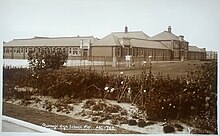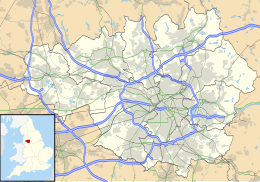Burnage Academy for Boys
| Burnage Academy for Boys | |
|---|---|
| Address | |
 | |
Burnage Lane , M19 1ER | |
| Information | |
| Type | Academy |
| Motto | Be The Best That You Can Be |
| Established | 1933 |
| Local authority | Manchester City Council |
| Department for Education URN | 140703 Tables |
| Ofsted | Reports |
| Head teacher | Ian Fenn |
| Staff | 120 |
| Gender | Boys |
| Age | 11 to 16 |
| Enrollment | 941 |
| Houses | Ash, Oak, Maple, Rowan |
| Website | http://www.burnage.manchester.sch.uk |
Burnage Academy for Boys (formerly known as Burnage High School) is a secondary school with academy status, located in Burnage, Manchester, England.
History
Grammar school

The school was founded in 1933 as Burnage High School for Boys in a building situated on Burnage Lane. In World War II (1939-45) a German aeroplane, shot down by gunfire during the Manchester Blitz, nose-dived into the school hall, causing severe damage and demolishing the organ.[1][2]
After the war, the hall was repaired but not until many years later was the organ replaced by a vastly inferior instrument. Around 1950 the school was given Grammar School status with the traditional grammar school ethos and curriculum. In 1958, a four-storey concrete building was added at the rear of the old buildings. This building accommodated extra classrooms (following the post-war baby-bulge) with the art rooms on the top floor. In the late '50s to mid-'60s this Grammar School was highly rated and competition for places was strong. In those days its intake was from Burnage, Didsbury, Levenshulme and Withington.
Comprehensive school

In 1967, the school became Burnage High School for Boys and merged with Ladybarn Secondary Modern School, which had previously been nearby on Briarfield Road near its junction with Parrs Wood Road. The Briarfield Road site then became the lower school (for years 7 to 9) while the Burnage Lane site remained the upper school (for years 10 and 11 plus the sixth form). This remained the case until 2000 when the sixth form was abolished and the lower and upper schools were amalgamated on the Burnage Lane site, which was expanded by a new buildings including a Sports Hall. The old school buildings on Briarfield Road were then demolished and the site was sold for housing development.
Media Arts College
In 2007, the school was given Media Arts College status and was renamed as Burnage Media Arts College in 2008.[3] Despite this change, it remained an all-boys school for 11-16 year-olds.
In 2010, the school was reconstructed under the Building Schools for the Future initiative which saw the original 1930s and 1950s buildings replaced by a new building. The 1999 building was refurbished and the Sports Hall (built in 2001) was also improved with a new gymnasium. Upon completion of the new main building, the old buildings were demolished and the grounds they once stood on were resurfaced to provide all-weather sports facilities.
Academy
Previously a community school administered by Manchester City Council, Burnage Media Arts College converted to academy status on 1 April 2014 and was renamed Burnage Academy for Boys, however, the school continues to co-ordinate with Manchester City Council for admissions.
Admissions
The school draws pupils from various districts of Manchester, including Didsbury, Levenshulme, Longsight, Rusholme, Fallowfield, Withington, Hulme, Ardwick, and Burnage itself. The majority of students live in Longsight, Levenshulme, Rusholme and Ardwick wards, which suffer from high levels of poverty, deprivation, and crime. As mentioned in its 2010 OFSTED report, over 90% of the school's students are from ethnic minorities, and over 64% are of South Asian heritage with more than 50% of all students speaking English as an additional language.[4]
OFSTED Inspections
The school's latest OFSTED report was conducted in 2012 and rated the school as "Good" (Grade 2).[5] This follows the school's last inspection in 2010 when it was rated merely as "Satisfactory" (Grade 3).
Academic performance
In the school's 2002 OFSTED report, it was noted that overall examination grades for students at the school in recent years were well below the national average.[6] The school has had consistently improving GCSE results since 2001 (with the exception of 2005 when results dipped, and in 2013 when there was a sharp drop), though they remain well below the national average.[7] GCSE performance results as published by the Department for Children, Schools and Families (DCSF) since 2001 are as follows:[8][9][10][11]
Percentage of students achieving 5 or more GCSE A* - C results or equivalent (national average for each year in brackets):
- 2001: 23% (50%)
- 2002: 33% (52%)
- 2003: 38% (53%)
- 2004: 42% (54%)
- 2005: 35% (56%)
- 2006: 38% (58%)
- 2007: 40% (61%)
- 2008: 50% (65%)
Percentage of students achieving 5 or more GCSE A* - C results including English and Maths (national average for each year in brackets):
- 2005: 27% (44%)
- 2006: 33% (46%)
- 2007: 28% (46%)
- 2008: 33% (48%)
- 2009: 40% (50%)
- 2010: 43% (54%)
- 2011: 50% (59%)
- 2012: 56% (59%)
- 2013: 43% (59%)
Controversies
In September 1986, the school made headline news when 13-year-old Asian pupil Ahmed Iqbal Ullah was fatally stabbed in the lower school playground by another 13-year-old pupil, Darren Coulburn, in what was believed to be a racially motivated attack. Coulburn, a juvenile delinquent who had already burned down the school art block in 1985 causing £50,000 of damage, was convicted of murder and detained indefinitely. The incident severely damaged the reputation of what was once a well-respected school in the district, and launched the MacDonald Inquiry into racism and violence in Manchester schools.[12] The Ahmed Iqbal Ullah Race Relations Resource Centre, established in 1999, was named in Ullah's memory.
In 2009, the school made headline news when teacher Mohammed Sarwar was arrested after police had obtained evidence that he had been leading a double life as the mastermind behind a major local drugs gang who had a large-scale operation to deal cocaine and cannabis. Sarwar, who was known as "The Teacher" to his gang, had taught I.T. at the school for seven years until his arrest. In April 2011, he was convicted and sentenced to 21 years in prison.[13] After his arrest, staff at the school also found crib sheets that Sarwar had drawn up to help his pupils cheat at their exams.[14]
Between 2009 and 2011, Salman Ramadan Abedi, the attacker of the 2017 Manchester Arena bombing, attended the school. While attending he was among a group of students who accused a teacher of Islamophobia for criticising suicide bombing.[15][16][17]
In 2012, the school made headlines again when former supply teacher Mutasem Alqtaishat was arrested for fraud after he collected weekly payments from young players at a local basketball club that he coached at and deposited the payments into his personal account for his own use over a five-month period. Alqtaishat received a 13-week prison sentence (suspended for one year), and was ordered to pay £400 and perform 180 hours of unpaid community service. In 2013, he was also struck off by the Teaching Agency for a minimum period of two years.[18][19]
Notable former pupils
Burnage Media Arts College
- Salman Abedi - linked to the 2017 Manchester Arena bombing[20]
Burnage High School for Boys
- Nadeem Ahmed - Market Trader of the year 2000, 2001 and 2012 respectively in Cheetham Hill Plaza, (15 years in Strangeways prison for Embezzlement)
- Darren Beckford - former Manchester City footballer
- Jason Beckford - former Manchester City footballer
- Wes Brown - Sunderland and England footballer.[21]
- Peter Coyne - former Manchester United footballer and England Youth Team player
- Dale Hibbert - original bass player with The Smiths, Author of "Boy Interrupted"
- Aziz Ibrahim - guitarist (worked with Simply Red, the Stone Roses)
- Brian Sterling-Vete - author, Guinness World Record Holder, motivational speaker, film-maker, TV presenter, actor, and entrepreneur.
- Menelik Watson - professional American Football player (Offensive Tackle for the Oakland Raiders from 2013-2016, and Denver Broncos from 2017-Present)
- Jim O'Neill, Baron O'Neill of Gatley - economist and government Minister[22]
Burnage Grammar School for Boys
- Alan Badel - stage, film and television actor
- Roger Byrne - Manchester United and England footballer killed in the Munich air disaster
- Michael Croft - Founder and Director of the National Youth Theatre[21]
- Norman Foster, Baron Foster of Thames Bank - architect[21]
- John Hutton - Author
- Sir Stephen Sherbourne CBE - Conservative political advisor
- Mike Smithson - Editor (since 2004) of Politicalbetting.com
- John Smithson - BAFTA award-winning film producer
References
- ^ Phythian, Graham. Blitz Britain: Manchester and Salford. History Press. ISBN 9780750965583. Retrieved 27 May 2017.
- ^ Nadin, Dennis Lloyd. Bombs Over Burnage. Archived from the original on 27 May 2017. Retrieved 27 May 2017.
{{cite book}}: Unknown parameter|deadurl=ignored (|url-status=suggested) (help) - ^ Qureshi, Yakub (2008-01-04). "Burnage school gets new status". The Asian News. Archived from the original on 2008-05-16.
{{cite news}}: Unknown parameter|deadurl=ignored (|url-status=suggested) (help) - ^ Burnage High School 2010 OFSTED report[permanent dead link]
- ^ OFSTED reports (Burnage Media Arts College)
- ^ 2002 OFSTED Report (pdf)[permanent dead link]
- ^ 2006 OFSTED report[permanent dead link]
- ^ DCSF School Attainment Tables 2001–04[permanent dead link]
- ^ DCSF Attainment Tables 2008
- ^ DCSF Attainment Tables 2009[permanent dead link]
- ^ Schools Performance Tables (2010-2013)
- ^ Murder in the Playground: Report of the Macdonald Inquiry into Racism and Racial Violence in Manchester Schools, Ian Macdonald, New Beacon Books (ISBN 978-1-872417-00-4)
- ^ "Manchester teacher who led drugs gang jailed". BBC News Manchester. BBC. 18 April 2011. Retrieved 29 August 2011.
- ^ "Teacher, 30, who led double life running cocaine gang faces jail". Daily Mail. 29 March 2011. Retrieved 26 August 2011.
- ^ Dearden, Lizzie (26 May 2017). "Salman Abedi once called RE teacher an 'Islamophobe' for asking his opinion of suicide bombers". The Independent. Retrieved 26 May 2017.
- ^ Simpson, John; Gibbons, Katie; Kenber, Billy; Trew, Bel (26 May 2017). "Abedi called teacher an Islamophobe". The Times. Retrieved 26 May 2017.
- ^ "Manchester attack: Who was Salman Abedi?". bbc.com. BBC. Retrieved 24 May 2017.
- ^ Yakub Qureshi (3 April 2013). "Struck off: The teacher who stole cash from kids' sports club". Manchester Evening News. Retrieved 9 December 2013.
- ^ Prohibition order - Department of Education[permanent dead link]
- ^ "Manchester attack: Who was Salman Abedi?". BBC News. 25 May 2017. Retrieved 25 May 2017.
- ^ a b c Burnage High School for Boys - Manchester UK Archived July 18, 2007, at the Wayback Machine
- ^ Jim O'Neill, Baron O'Neill of Gatley

